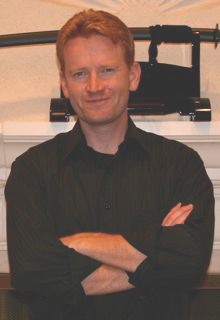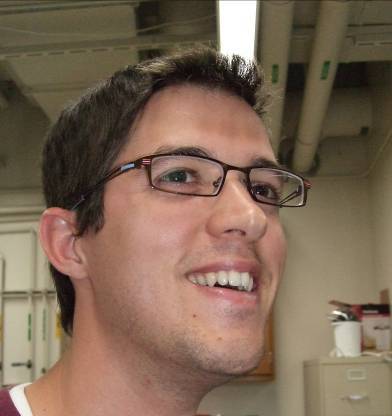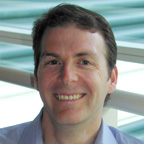














 Jerred Chute
Jerred ChuteMr. Chute is a 4th year Ph.D. candidate at the University of California in Santa Barbara, majoring in Materials Chemistry. His research at LANL this summer concerns molecular simulations of dendrimers end functionalized with multiple types of linear polymeric chains. Of interest are the phase morphologies of individual architectures, coalescence of micelles/vesicles, and interactions with lipid bilayers and patterned functionalized surfaces.
UCSB Advisor: Craig Hawker
Research:Mr. Diebold is finishing his third year as a graduate student in the Materials Department at UC Santa Barbara. His research focuses on investigating the electrical properties of filled silicone elastomer. More specifically, he is interested in the phenomena of dielectric breakdown and how filler particle interactions affect the dielectric behavior of such composite films.
UCSB Advisors: David Clarke and Ed Kramer
Research: John Frostad
John FrostadMr. John Frostad is a third-year graduate student at UCSB. He works with Dr. Gary Leal in the Chemical Engineering Department in the area of Fluid Mechanics. His research is aimed at understanding the dynamics of bubble coalescence as it relates to the formation of polymeric foams. This is primarily carried out by experiments coalescence experiments between two bubbles and scaling analysis.
UCSB Advisor: Gary Leal
Research:
 Brian Giera
Brian GieraMr. Giera is a 1st year graduate student at the UCSB Chemical Engineering. His current research focus at LANL is to use molecular dynamics (MD) simulations in order to investigate the formation of the electric double layer (EDL) in electrolytic and ionic liquids whose ions have different relative sizes and valencies.
UCSB Advisors: Todd Squires and Scott Shell
Research: Christopher Hammetter
Christopher HammetterMr. Hammetter is a fourth-year graduate student at UCSB. He is in the Department of Mechanical Engineering and working in the area of structural materials. This summer at LANL He is working on finite element modeling of representative volume elements of elastomeric periodic structures in order to better understand how parameters in the microstructure affect the behavior of the structure as a whole. This information will be useful to certain aspects of nuclear stockpile surety and to the design of materials for impact absorption in both industry applications and military threat protection.
UCSB Advisors: Bob McMeeking and Frank Zok
Research: Miguel Jimenez
Miguel Jimenez
Mr. Miguel A. Jimenez is a Ph.D student in the Department of Mechanical Engineering at UC Santa Barbara. His research is concerned with the modeling and simulation of the electromechanical response of dielectric elastomer actuators. He is interested in developing finite element tools for the analysis of problems in dielectic elastomer actuators involving finite deformations as well as material and geometric nonlinearities.
Research:
Molecular dynamics analysis of colloids flow and near surfaces.
Donghun Kim is a Ph. D. candidate in the department of chemical
engineering at UC Santa Barbara. He is investigating functionalized
mesoporous inorganic materials for electrochemical energy storage
devices. Mesoporous materials, which have larger pores and higher
structure ordering than traditional porous materials, provide enhanced
mass transport in the pores. His research focuses on controlling the
pore size and structure and tuning various properties by using surface
modifications. The mesoporous materials optimized for the electrodes
and proton exchange membranes of hydrogen fuel cells are tested at
LANL by collaborating with Dr. Zelenay and Dr. Kim.
UCSB Advisor: Bradley F. Chmelka
 Trevor Marks
Trevor MarksMr. Marks is a Ph.D. candidate in the Mechanical Engineering Department at UC Santa Barbara. His research is focused on developing an understanding of the relationship, interaction, and influence between macro-properties of foam materials and the geometrical form of their microstructure.
Research: Rob Messinger
Rob MessingerMr. Messinger is a Ph.D. student at UC Santa Barbara majoring in Chemical Engineering. He is investigating molecular origins of macroscopic mechanical properties in organic-inorganic cellular materials. He specializes in multi-dimensional solid-state nuclear magnetic resonance (NMR).
Research: Arthur Scholz
Arthur ScholzMr. Scholz is a 4th year of graduate school studying Materials Science at the University of California in Santa Barbara. The focus of his research at LANL is probing the relationship between nanoscale structures and bulk material properties of filled polymer networks.
Research: Daniel Shoemaker
Daniel ShoemakerMr. Shoemaker is a fourth-year graduate student in the Materials Department at UCSB, mentored by Prof. Ram Seshadri. At LANL he collaborates with Thomas Proffen and Anna Llobet at the LANSCE Lujan Center. His research focuses on using neutron total scattering to describe structure-property relations in disordered, magnetic, and functional oxides. This includes least-squares refinement and reverse Monte Carlo simulations of the real-space pair distribution function. In 2001, he was awarded the 23rd Rosen prize "for the most outstanding doctoral or master's thesis based on experimental or theoretical research performed at LANSCE."
Research: Dongxu Zhou
Dongxu ZhouMr. Zhou is a PhD student of Bren School of Environmental Science and Management at UC Santa Barbara. His research focuses on the transport of nanoscale particles under natural and engineering conditions. Both macroscopic and microscopic approaches are being employed to investigate the underlying mechanisms of particle aggregation and deposition.
Research: Frank Brown
Frank BrownResearch in my group is entirely theoretical/computational in nature. Our interests lie at the interface between physical chemistry and biophysics and we use a variety of tools spanning the traditional fields of statistical mechanics, hydrodynamics, elasticity theory and quantum mechanics in our research efforts. Recent work has focused on the dynamics and structure of biomembranes and the interpretation of
single molecule spectroscopy experiments.
Please see our group webpage for more details.
Links:
 Craig Hawker
Craig HawkerCraig J. Hawker, Ph.D. is currently Director of the Materials Research Laboratory and a Professor of Chemistry, Biochemistry and Materials at the University of California, Santa Barbara. From 1993-2004 he was a Research Staff Member and an investigator in the NSF Center for Polymer Interfaces and Macromolecular Assemblies at the IBM Almaden Research Center. He received a B.Sc. (Hons) degree and University Medal in Chemistry from the University of Queensland in 1984 and a Ph.D. in bioorganic chemistry from the University of Cambridge in 1988 under the supervision of Prof. Sir Alan Battersby. Jumping into the world of polymer chemistry, he undertook a post-doctoral fellowship with Prof. Jean Frechet at Cornell University from 1988 to 1990 and then returned to the University of Queensland as a Queen Elizabeth II Fellow from 1991 to 1993. He has been honored by the 2000 Young Scientists Award from the International Union of Pure and Applied Chemists, the 2001 Carl S. Marvel Award in Creative Polymer Science, the 2003 Cooperative Research Award with Professor Tom Russell, 2004 Industrial Scientist Award, 2005 ACS Award in Applied Polymer Science from the American Chemical Society, the 2005 Dutch Polymer Award and the 2007 Hermann Mark Scholar Award. In addition to a variety of named lectureships, Dr. Hawker is Editor of the Journal of Polymer Science, Polymer Chemistry, Adjunct Professor of Chemistry at the University of Queensland and serves as a consultant to a variety of US and international companies. His research has focused on the interface between organic and polymer chemistry with emphasis on the design, synthesis, and application of well-defined macromolecular structures in biotechnology, microelectronics and surface science.
Professor of Chemistry and Macromolecular Science and Engineering, University of Michigan
 Arturo Keller
Arturo KellerArturo A. Keller (Ph.D. Stanford, 1996) is Professor of Biochemistry at the Bren School. He holds a joint appointment in Mechanical and Environmental Engineering at UCSB. His research and teaching interests focus on water quality management and the fate and transport of pollutants in the environment. Dr. Keller is known for his involvement in the phasing out of the gasoline additive MTBE as part of a UC-wide project; his research found MTBE to seriously affect water resources while providing only modest air quality benefits relative to other alternatives. Dr. Keller also was the facilitator for the award-winning Nitrogen TMDL process for the Santa Clara River. The steering committee received the 2003 H. David Nahai Water Quality Award for their work. He has also worked with several Regional Water Quality Control Boards on TMDL processes, including nutrients in the Napa River, PCBs in San Francisco Bay, organophosphate pesticides in the Newport Bay watershed, and an assessment of TMDL priorities in the South Coast area of Santa Barbara County. He has been recognized with the Bren School Teaching Award. Dr. Keller is also well-known for his expertise in the fate and transport of pollutants, including nanoparticles, organic liquids (NAPLs), and persistent organic pollutants associated with clay particles; he has over 90 peer-reviewed publications in top journals. His research team also works on technologies to solve important water-quality problems, and recently was covered in the New York Times for a major improvement in the technology to skim oil spills in marine environments, which can significantly reduce the risk of the oil spill reaching coastal resources. Recently a novel nanomaterial was developed to deal with the contamination of persistent organic pollutants, a major legacy issue. Several patents have resulted from these various projects.
 Ed Kramer
Ed KramerProfessor Kramer received a B.Ch.E. Degree in Chemical Engineering from Cornell University in 1962 and a Ph.D. in Metallurgy and Materials Science from Carnegie-Mellon University in 1966. He was a NATO Postdoctoral Fellow at Oxford with Sir Peter Hirsch, FRS, before joining the faculty of Cornell University in 1967 where he was appointed the Samuel B. Eckert Professor of Materials Science and Engineering in 1988. In 1997 he joined the faculty of UCSB where he holds a joint appointment in Materials and Chemical Engineering. Professor Kramer's current research activities focus on polymer interfaces using a variety of depth profiling and microscopic imaging methods. His group is interested in the fracture of polymer interfaces and adhesion, from a micromechanical and molecular viewpoint. His work on grafting reactions at polymer/polymer interfaces seeks to understand the role of chain length and chemical functionality in the grafting kinetics and on the instabilities that develop as grafting proceeds. The control of morphology in phase separated thin films by controlling interface interactions is another important theme as is the diffusion of block copolymers where the ordered microstructure gives rise to thermodynamic barriers to diffusion of individual chains.
 Gary Leal
Gary LealGary Leal is professor of chemical engineering at the University of California in Santa Barbara. He also holds positions in the Materials Department and in the Department of Mechanical Engineering. He has taught at UCSB since 1989. Before that, from 1970 to 1989 he taught in the chemical engineering department at Caltech. His current research interests are focused on fluid mechanics problems for complex fluids, as well as the dynamics of bubbles and drops in flow, coalescence, thin-film stability, and related problems in rheology. In 1987, he was elected to the National Academy or Engineering. His research and teaching have been recognized by a number of awards, including the Dreyfus Foundation Teacher-Scholar Award, a Guggenheim Fellowship, the Allan Colburn and Warren Walker Awards of AlChE, the Bingham Medal of the Society of Rheology, and the Fluid Dynamics Prize of the American Physical Society. Since 1995, Professor Leal has been one of the two editors of the AIP journal Physics of Fluids and he has also served on the editorial boards of numerous journals and the Cambridge Series in Chemical Engineering. He received his Bachelor’s degree from the University of Washington, and his Master’s and Ph.D. from Stanford University.
 Robert McMeeking
Robert McMeeking Fred Milstein
Fred Milstein Thuc-Quyen Nguyen
Thuc-Quyen NguyenT.-Q. Nguyen obtained her B.S., M.S., and Ph.D. from UCLA in 1997, 1999, and 2001 respectively. She received several awards including the Dissertation Awards from the Chemistry Department at UCLA and the University of California for outstanding performance in research in Physical Chemistry and the Outstanding Innovative Research Award of the Advanced Materials. She was a research associate in the Department of Chemistry and the Nanocenter at Columbia University working with Louis Brus and Colin Nuckolls. She also spent time at IBM Research center at T. J. Watson (Yorktown Heights, NY) working with Richard Martel and Phaedon Avouris. She joined the faculty at UCSB in 2004.
 Ram Seshadri
Ram SeshadriAfter some years as a post-doctoral fellow in Caen, France, and in Mainz, Germany, Seshadri joined the faculty of the Indian Institute of Science in 1999. He moved to the Materials Department, UCSB in 2002 as an Assistant Professor, and was promoted to Associate Professor in 2006. Since Fall 07, he is also an Associate Professor in the Department of Chemistry and Biochemistry. Ram is the author of over 140 publications in the broad area of functional inorganic materials, and is a recipient of the ExxonMobil Solid State Chemistry Faculty Fellowship of the American Chemical Society.
 Joan-Emma Shea
Joan-Emma SheaResearch in the Shea group focuses on developing and applying the techniques of statistical and computational physics to the study of biological problems. Current work involves the investigation of cellular processes such as in-vivo protein folding and protein aggregation.
Protein Folding in the Cell
Proteins are among the most important building blocks of life. They originate in the ribosome where they are synthesized as a chain of amino acids. Their sequence is encoded in the cellular DNA, and this sequence in turn determines the fold of the protein. Only in its folded state can the protein serve its biological role. The kinetic and thermodynamic mechanisms that enable the protein to reach its three dimensional structure from a one dimensional chain of amino acids are still under debate, despite over thirty years of sustained theoretical and experimental effort.
Protein Intermediates, Protein Misfolding and Aggregation
Experiments have shown that proteins can fold efficiently through a large number of different mechanisms. Certain proteins appear to fold in a "two-state" manner, proceeding directly from the unfolded state to the folded state, while others adopt a multi-state mechanism, significantly populating one or more stable intermediate species as they fold. The reasons behind these mechanistic differences are not well understood. In fact, it is unclear why nature would have evolved a multi-state folding mechanism when proteins can fold without intermediates.
The role of intermediates in folding is hotly debated, with experimental studies reaching seemingly contradictory conclusions. Certain experiments suggest that intermediates aid folding by guiding the protein to the folded state while other studies imply that intermediates hinder folding by acting as kinetics traps. Our research focuses in part on establishing the mechanistic differences between two and multi-state folders and determining which factors (structural, thermodynamic and kinetic) are responsible for each type of behavior.
Additionally, the formation of certain types of intermediates in the cell can be problematic. The crowded cellular environment is conducive to the formation of "misfolded" intermediate protein species that can interact to form stable but biologically non-functional aggregated structures. Diseases such as Alzheimer's, cystic fibrosis and type II diabetes have been linked to such aggregation processes. Interestingly, the ability to form aggregated structures is not unique to disease related proteins. Recent studies have demonstrated that given suitable conditions, any protein is capable of aggregating. This implies that the aggregated state is an inherent structural form of a protein, just like the unfolded and the folded state.
We are investigating the conditions that lead to the formation of misfolded protein structures as well as the mechanism by which these structures associate to form aggregates. Our approach involves a combination of Monte Carlo and Molecular Dynamics simulations using coarse grained as well as atomically detailed models. These simulations are complemented by analytical studies.
Department of Chemical Engineering, UCSB
 Todd Squires
Todd SquiresTodd Squires is an Assistant Professor at the University of California in Santa Barbara. He received his Bachelor’s degrees in Russian Language and Literature and Physics from the University of California in Los Angeles. He received a C.A.S. with Distinction from the University of Cambridge and his Ph.D. in Physics from Harvard University. He has been awarded the NSF Career Award and named one of four “Rising Stars” by the Chronicle of Higher Education. He was organizer and co-chair of “Colloidal Hydrodynamics” AIChE Annual Meeting, Salt Lake City, Utah, and organizer and leader of Short Course on Microfluids and Rheology, Society of Rheology Annual Meeting, Salt Lake City, Utah, both in 2007. He is fluent in Russian and French and has studied Arabic. His current research focuses on fluid mechanics and transport science; specifically how to understand and exploit the various physical effects that arise in micron-scale systems, both theoretically and experimentally. Examples include induced-charge electrokinetic techniques for microfluidic manipulation (with an eye towards portable or implantable devices), ‘pore-scale engineering’ techniques for analytical purifications and separations, and microrheology – both active (to characterize a material’s nonlinear response), and passive (for linear viscoelastic properties).
